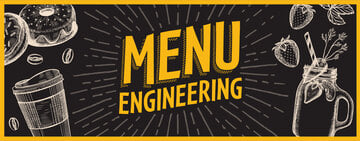Whether you first learned about butter boards through Brooklyn-based cook Justine Doiron’s viral TikTok video, or years ago through Joshua McFadden’s cookbook Six Seasons, it’s easy to see why the masses are intrigued, inspired, and hungry. Butter boards have taken over social media as the newest food trend, with chefs and creators making their own recipe combinations or putting their own spin on the idea.
With growing popularity comes consumer curiosity, making butter boards a great addition to your starters and appetizers. Keep reading to learn how to make a butter board for your restaurant’s menu.
How to Make a Butter Board
Watch our step-by-step video for a simple tutorial on butter boards.
Butter Board Instructions
Bringing the charcuterie-adjacent trend to your menu can be a great investment. Here’s how to make a butter board according to Doiron, plus a few extra tips and suggestions to make your butter board unique and the best it can be:
1. Choose a Board

This is the backdrop of your butter board. Keep in mind the size of the board by considering how much butter will go on it. Also, if you’d like to place other accompaniments on the board instead of separate side plates, consider room for that.
The material of the butter board is another consideration. Here are the pros and cons of different board materials to know:
- Marble - Marble is the best board material for a butter board. Not only does it create a beautiful backdrop, but it is also super easy to clean. Marble also has natural cooling properties, keeping your butter perfectly chilled.
- Granite - Like marble, granite is a beautiful butter board backdrop, has natural cooling properties, and is easy to clean. However, the divots in granite can make cleaning a little more tedious.
- Teakwood - Teakwood is the best wood-appearing board to use. It is very sturdy and has a high oil content, not to mention the natural grains make a beautiful, rustic appearance.
- Bamboo - Bamboo is also a great material option as it gives the look of wood but is usually more affordable and durable. However, it is also a bit difficult to wash away oils from a bamboo board.
- Wood - While wood does make a warm, cozy aesthetic for a butter board, the oils from the butter can easily seep into the wood, making it very hard to clean.
2. Select a Butter
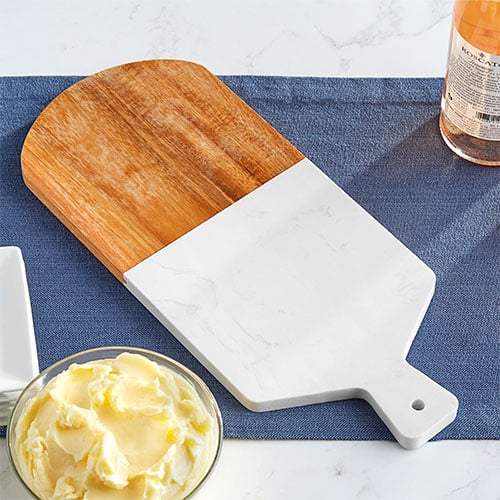
As the main ingredient, choosing which variety of butter you’d like to go with is essential to the overall quality of your butter board. You will want to use a very high-quality butter, so this is not the time to pick the cheapest butter at the store.
Below are the best kinds of butter to use for a butter board:
- Grass-Fed Butter - Grass-fed butter is made from the milk of pasture-raised cows that are fed a grass-only diet. It has a sunny yellow color and a bright, rich, and creamy flavor.
- Smen Butter - Smen is a fermented Moroccan butter that has been made and used in Middle Eastern and a few North African cuisines for centuries. The fermentation process creates a strong, piquant, cheesy flavor and soft yellow color.
- European Butter - With a high percentage of butterfat, European butter is deliciously rich and tangy with a beautiful golden yellow color.
- Goat Butter - Goat butter is just like regular butter but is made from goat milk instead of cow milk. It has a rich cream color with a flavor that is mildly tangy and pungent with an overall bright and smooth flavor.
- Amish Butter - Amish butter is made from Amish family-owned farms where fresh cow’s milk is slowly hand-churned to a buttery perfection. The butter is usually a deep yellow color with a mild, milky, and slightly acidic taste.
- Cultured Butter - Cultured butter has live bacterial cultures added to the cream and is left to ferment before the churning process begins. This results in a tangy, acidic, fuller lactic flavor and light cream color.
This is where you can add other flavorings to the butter to give your butter board more depth. Mix in spices to your butter before spreading, or save time by using compound butter.
Shop All Butter3. Style Butter on Board
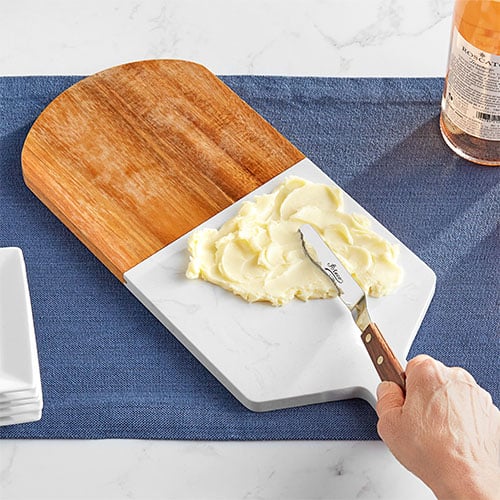
Once you have selected a butter and a board, it’s time to put them together. Below is how to style butter on a butter board:
- Make sure your butter is at room temperature, but not melted in any way.
- Map out where you’d like the butter to reach on the edges of the board. Keep in mind accompaniments that will also be on the board, if any.
- With a mini offset spatula, carve away chunks of the butter and artistically spread them on the board. Make wave patterns, checkered patterns, or whatever you think looks nice!
- Do this until it reaches your pre-planned edges.
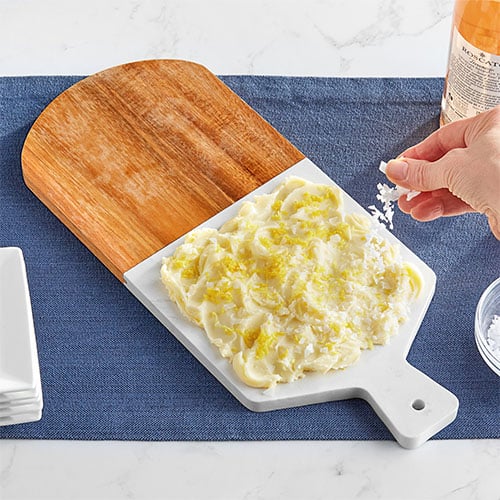
4. Add Baseline Seasonings
Once your butter has been styled onto the board, add the basic seasonings. Doiron suggests flaky salt and lemon zest. These are great baseline seasonings to use no matter where you take your toppings or flavor combinations.
5. Decorate with Toppings
Now is the time to get especially creative. This is what will help make your butter board menu item especially appealing. Try these butter board topping ideas to heighten the look and flavor:

- Edible flowers
- In-season fruit
- Fresh herbs
- Different honeys
- Grated garlic
- Chili flakes
- Roasted nuts
- Varieties of olives
- Sundried tomatoes
6. Serve with Accompaniments
The most ideal accompaniment for a butter board is a crusty loaf of bread, such as a sourdough, country loaf, or extra crispy baguette. The bread’s crumb is tender enough to be a plush bite with the butter, while the crust is thick enough to help you scrape up the butter if you’re not using a butter knife with your butter board.
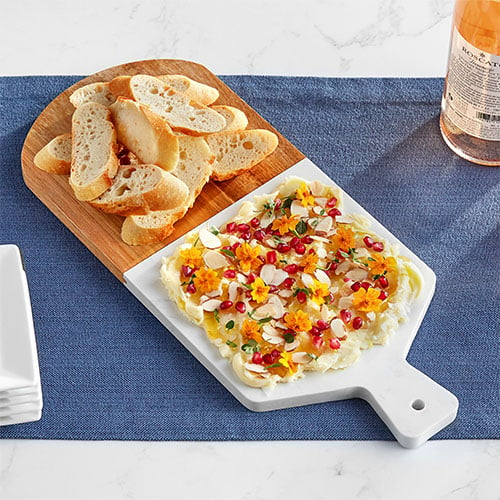
If you want to serve more than just bread along with your butter board, here are other accompaniments to try:
- Crackers
- Radishes
- Mini bell peppers
- Apples
- Pears
Butter Board Flavor Pairings
If you want to make a great-tasting butter board but aren’t sure where to start with flavor pairings, we have a few sweet and savory butter board ideas listed below:
- Fig, honey, fresh thyme, toasted almonds, and edible flowers
- Butter whipped with pumpkin puree, topped with maple syrup, pumpkin spice, candied pecans, and salted pepitas
- Sundried tomatoes, capers, roasted garlic, and basil
- Butter whipped with miso, charred scallions, toasted sesame seeds, and a drizzle of chili oil
- Roasted eggplant, chopped olives, thinly sliced shallots, tomatoes, and garlic
- Marcona almonds, shaved manchego, mixed olive slices, chorizo crumbles, and toasted chickpeas
Which Wines to Pair with a Butter Board
If you want to offer a butter board on your menu, you can maximize profit by suggesting wine pairings, especially if you already have a wine list. Below are the best wines to serve with a butter board:
- Riesling
- Chenin Blanc
- Chardonnay
- Sauvignon Blanc
How to Make Your Butter Board Unique
Butter boards are fun, interactive, and delicious, which means everyone is making them. Here are ways to add a new spin on your butter board to make it stand out:
- Add to a Charcuterie Board - A charcuterie board is made up of cheeses, cured meats, and other accompaniments. But what if you left a space on the board for butter, too? Next time you’re building a charcuterie board, style butter on the board before adding all of the other components.
- Split into Different Sections - Give your guests the ultimate tasting flight. Split the butter board into as many different sections as you want, each showcasing different toppings or different kinds of butter.
- Utilize Local Ingredients Only - Make connections with your community. Contact local dairy and produce farmers to create a localized butter board collaboration. And don’t forget to call this out on your menu – guests love to know that their money is supporting the community!
If you’re looking to switch up your menu items a bit, consider adding a butter board to your starters. It’s a really great interactive dish that can help set the meal on the right foot for your customers to enjoy the rest of their reservation!



